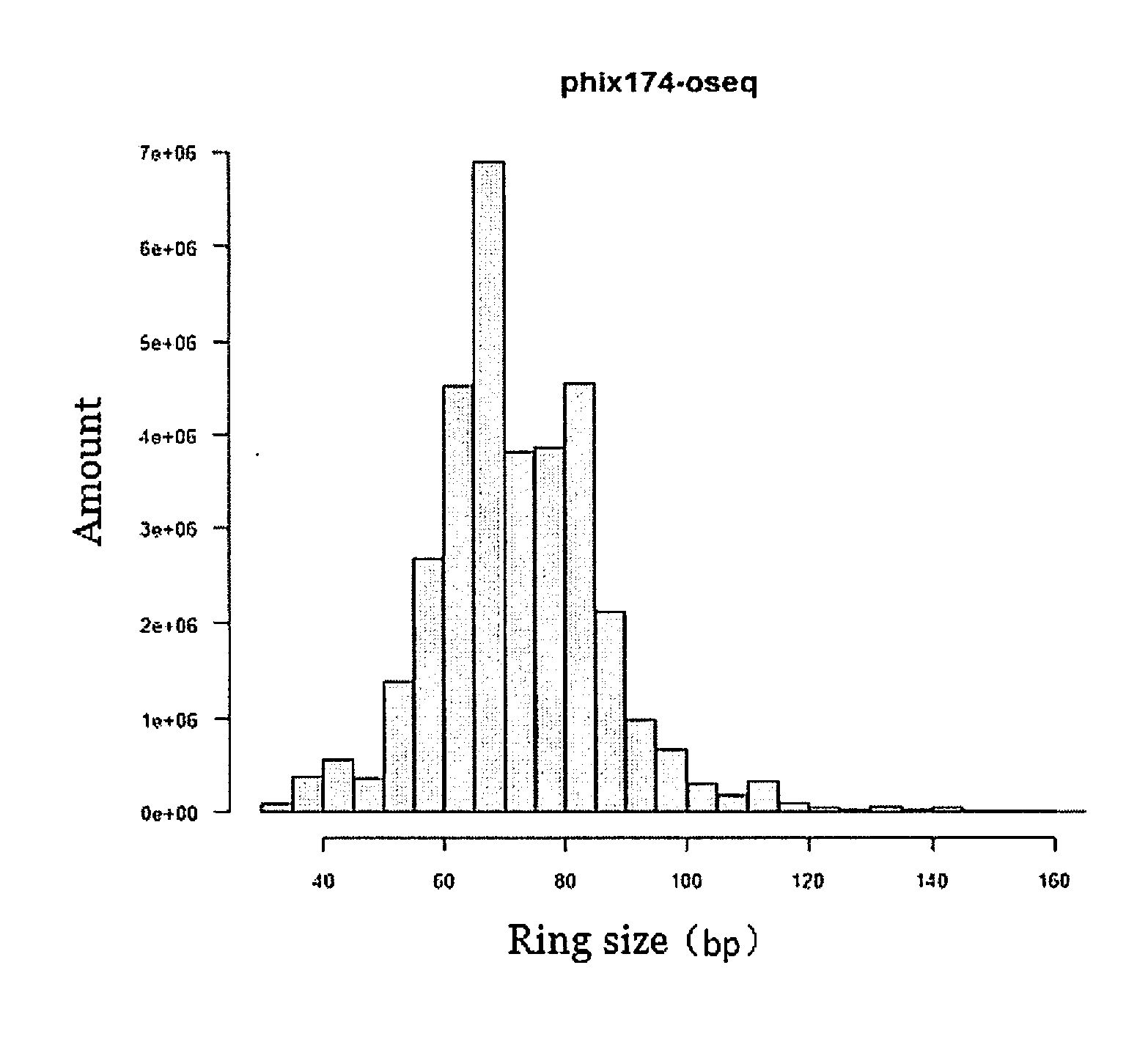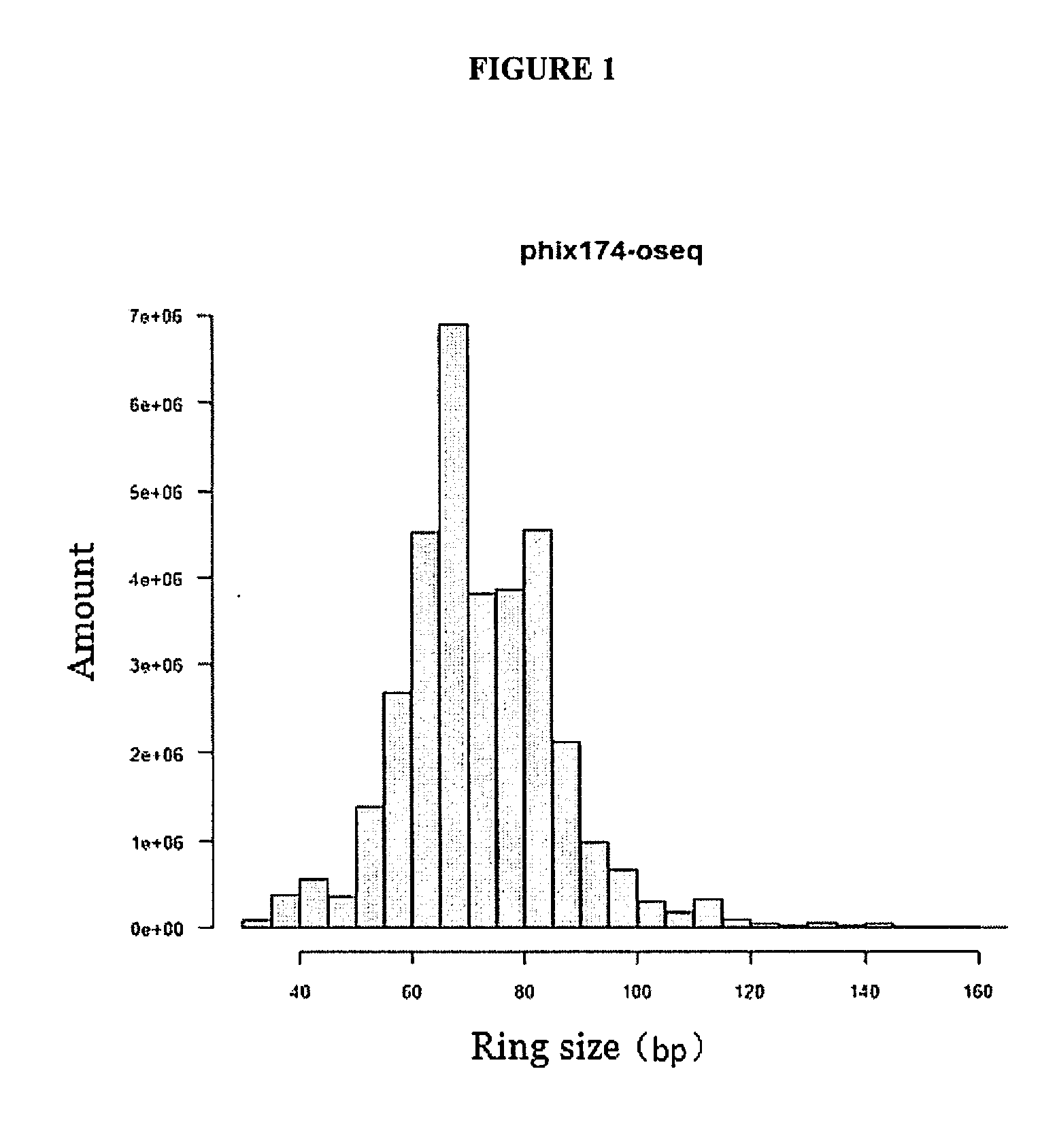Sequencing library, preparation method and use thereof
a technology of a library and a sequencer, applied in the field of sequence libraries, can solve the problems of affecting research, affecting the accuracy of research, and 1% of errors, so as to achieve the effect of eliminating errors and determining ultra-accuracy
- Summary
- Abstract
- Description
- Claims
- Application Information
AI Technical Summary
Benefits of technology
Problems solved by technology
Method used
Image
Examples
example 2
Construction of Equidirectional Alternating Concatemer Library for Human Exon Sequence to be Tested and Tag Sequence According to Scheme I (Illumina Sequencing Platform)
[0203]1) DNA Fragmentation
[0204]The used instruments and reagents were as those of Example 1. Ultrasonic breaker was used to break 1 μg of purified human peripheral blood genome DNA into 300 bp (Intensity: 4, Duty Cycle: 10%, Cycles per Burst: 200, Temperature: 4° C., time: 60 s, number of cycles: 2), the breaking system was in an amount of 50 μl.
[0205]4% Agarose gel electrophoresis (80V, 70 min; 1×TAE), cutting gel and recovering 80˜130 bp fragments, brief recovering steps: 6 times volume of buffer QG sol, adding with same volume of isopropanol, mixing and being separated by chromatography, eluted with buffer QG, eluted with buffer PE, dried by airing, eluted with 56 μl ddH2O. See details in specification of QIAGEN MinElute Gel Extraction Kit.
[0206]2) End-Filling
[0207]Reagents: see also those in Example 1.
[0208]Frag...
example 3
Construction of Equidirectional Alternating Concatemer Library for Peripheral Blood Free DNA Sequence to be Tested and Tag Sequence According to Scheme I (Illumina Sequencing Platform)
[0342]1) Extracting Peripheral Blood Free DNA and Determining Fragment Size Thereof
[0343]Instruments and reagents:
[0344]QIAGEN: QIAamp Circulating Nucleic Acid Kit, catalog #: 55114
[0345]Agilent: 2100 bioanalyzer
[0346]2 ml of blood plasma was collected, QIAamp Circulating Nucleic Acid Kit of QIAGEN was used to extract DNA (cell-free circulating DNA) in the plasma, and elution was performed by using 20 μl ddH2O (the extraction method could be seen in the specification of the kit). 2100 bioanalyzer of Agilent was used to determine the size distribution of the extracted fragments. It could be seen in the results that the free DNA fragments of normal human subjects had a size centered around 172 bp, a distribution range of about (130 bp-230 bp), and a concentration of 0.354 ng / μl, while the free DNA fragme...
example 4
Construction of Equidirectional Alternating Concatemer Library for Sequence to be Tested and Tag Sequence According to Scheme II (Illumina Sequencing Platform)
[0433]Steps:
[0434]1) DNA Fragmentation
[0435]Instruments and reagents: see those in Example 1.
[0436]Ultrasonic breaker was used to break 1 μg of the purified Drosophila melanogaster genome DNA into 150-200 bp (Intensity: 5, Duty Cycle: 10%, Cycles per Burst: 200, Temperature: 4° C., time: 60 s, number of cycles: 5), the breaking system was in an amount of 50 μl.
[0437]4% agarose gel electrophoresis (80V, 70 min; 1×TAE), cutting gel and recovering 60-90 bp fragments, brief recovering steps: 6 times volume of buffer QG sol, adding with same volume of isopropanol, mixing homogeneously and then being separated by chromatography, eluted with buffer QG, eluted with buffer PE, dried by airing, eluted with 56 μl ddH2O. See details in specification of QIAGEN MinElute Gel Extraction Kit.
[0438]2) End-Filling
[0439]Reagents: see those in Exa...
PUM
| Property | Measurement | Unit |
|---|---|---|
| Temperature | aaaaa | aaaaa |
| volume | aaaaa | aaaaa |
| pH | aaaaa | aaaaa |
Abstract
Description
Claims
Application Information
 Login to View More
Login to View More - R&D
- Intellectual Property
- Life Sciences
- Materials
- Tech Scout
- Unparalleled Data Quality
- Higher Quality Content
- 60% Fewer Hallucinations
Browse by: Latest US Patents, China's latest patents, Technical Efficacy Thesaurus, Application Domain, Technology Topic, Popular Technical Reports.
© 2025 PatSnap. All rights reserved.Legal|Privacy policy|Modern Slavery Act Transparency Statement|Sitemap|About US| Contact US: help@patsnap.com


